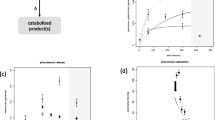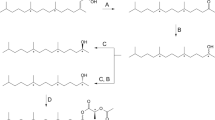Abstract
The dependence of the electrophysiological activity on the change of double-bond configuration of (Z)-5-decenyl acetate, a pheromone component of the turnip moth,Agrotis segetum, and a dienic analog, (E)-2,(Z)-5-decadienyl acetate, have been investigated by single-cell measurements and molecular mechanics calculations (MM2). A previously reported model for the interaction between a moth sex pheromone component and its receptor has been refined. This new model gives an essentially quantitative correlation between the measured activities and the calculated conformational energies for a biologically active conformation defined by the model. Previously obtained structure-activity results for chain-elongated analogs of (Z)-5-decenyl acetate are significantly improved by the refined model. The effect of a change of the double-bond configuration on the substrate-receptor interaction is not additive but depends on the conformational properties of the entire molecule.
Similar content being viewed by others
References
Allinger, N.L., andYuh, Y.H. 1980. Quantum Chemistry Program Exchange 11, Program No. 395.
Ando, T., Vu, M.H., Yoshida, S., andTakahashi, N. 1982. Stereoselective synthesis of some isomers of dodecadien-1-ol: Compounds related to the pine moth sex pheromone.Agric. Biol. Chem. 46:717–722.
Arn, H., Städler, E., Rauscher, S., Buser, H.R., Mustaparta, H., Esbjerg, P., Philipsen, H., Zethner, O., Struble, D.L., andBues, R. 1980. Multicomponent sex pheromone inAgrotis segetum: Preliminary analysis and field evaluation.Z. Naturforsch. 35c:986–989.
Bengtsson, M.,Liljefors, T., andHansson, B.S. 1987.Bioorg, Chem., in press.
Bestmann, H.J., andVostrowsky, O. 1982. Structure-activity relationships in insect pheromones. A dynamical model of pheromone interactions with receptor sites, pp. 253–263,in W. Breipohl (ed.). Olfaction and Endocrine Regulations. IRL Press, London.
Bestmann, H.J., Vostrowsky, O., Koschatzky, K.H., Platz, H., Brosche, T., Kantardjiew, I., Rheinwald, M., andKnauf, W. 1978. (Z)-5-Decenyl acetate, ein Sexuallockstoff für Männchen der SaateuleAgrotis segetum (Lepidoptera).Angew. Chem. 90:815–816.
Burkert, U., andAllinger, N.L. 1982. Molecular Mechanics. American Chemical Society, Washington, D.C.
Hallberg, E. 1981. Fine-structural characteristics of the antennal sensilla ofAgrotis segetum (Insecta: Lepidoptera).Cell Tissue Res. 218:209–218.
Houx, N.W.H., Voerman, S., andJongen, W.M.F. 1974. Purification and analysis of synthetic insect sex attractants by liquid chromatography on a silver-loaded resin.J. Chromatogr. 96:25–32.
Kafka, W.A., andNeuwirth, J. 1975. A model of pheromone molecule-acceptor interaction.Z. Naturforsch. 30c:278–282.
Kaissling, K.-E. 1974. Sensory transduction in insect olfactory receptors, pp. 243–273,in L. Jaenicke (ed.). Biochemistry of Sensory Functions. Springer Verlag, Berlin.
Kaissling, K.-E. 1976. The problem of specificity of olfactory cells, pp. 137–144,in G. Benz (ed.). Structure-Activity Relationships in Chemoreception. Information Retrieval, London.
Kaissling, K.-E. 1977. Structure of odour molecules and multiple activities of receptor cells, pp. 9–16,in J. Le Magnen and P. Mac Leod (eds.). Olfaction and Taste VI. Information Retrieval, London.
Kikuchi, T. 1975. Correlation of moth sex pheromone activity with molecular characteristics involved in conformers of bombykol and its derivatives.Proc. Natl. Acad. Sci. U.S.A. 72:3337–3341.
Koyama, Y., andIkeda, K. 1980. Raman spectra and conformations of thecis-unsaturated fattyacid chains.Chem. Phys. Lipids 26:149–172.
Liljefors, T. 1983. MOLBUILD—an interactive computer graphics interface to molecular mechanics.J. Mol. Graphics 1:111–117.
Liljefors, T., Thelin, B., Van Der Pers, J.N.C., andLÖfstedt, C. 1985. Chain-elongated analogs of a pheromone component of the turnip moth,Agrotis segetum. A structure-activity study using molecular mechanics.J. Chem. Soc. Perkin Trans. 2:1957.
Löfstedt, C., Van Der Pers, J.N.C., Löfquist, J., Lanne, B.S., Appelgren, M., Bergström, G., andThelin, B. 1982. Sex pheromone components of the turnip moth,Agrotis segetum: Chemical identification, electrophysiological evaluation and behavioral activity.J. Chem. Ecol. 8:1305–1321.
Neuwirth, J. 1973. Multiple-site Wechselwirkung zwischen Duftmolekülen. Diplomarbeit, Tech. Universitat, Physik Dept., München.
Olsson, A.-M., JÖnsson, J.A., Thelin, B., andLiljefors, T. 1983. Determination of the vapor pressures of moth sex pheromone components by a gas Chromatographic method.J. Chem. Ecol. 9:375–385.
Priesner, E. 1979. Specificity studies on pheromone receptors in noctuid and tortricid Lepidoptera, pp. 57–71,in F.J. Ritter (ed.). Chemical Ecology: Odour Communications in Animals. Elsevier/North Holland, Amsterdam.
Priesner, E. 1980. Sensory encoding of pheromone signals and related stimuli in male moths, pp. 359–366,in Neurobiology and Insecticide Action (Neurotox 1979). Society of Chemical Industry, London.
Priesner, E. 1983. Receptors for di-unsaturated pheromone analogues in the male summerfruit tortrix moth.Z. Naturforsch, 38c:874–877.
Priesner, E., Jacobson, M., andBestmann, H.J. 1975. Structure-response relationships in noctuid sex pheromone reception.Z. Naturforsch. 30c:283–293.
Shimanouchi, T., Abe, Y., andAlaki, Y. 1971. Stable conformations of 1,4-polybutadiene chains and their model compound molecules.Polymer J., 2:199–211.
Steck, W., Underhill, E.W., andChisholm, M.D. 1982. Structure-activity relationships for North American noctuid moths.J. Chem. Ecol. 8:731–754.
Van Der Pers, J.N.C., andDen Otter, C.J. 1978. Single cell responses from olfactory receptor of small ermine moths (Lepidoptera: Yponomeutidae) to sex attractants.J. Insect. Physiol. 24:337–343.
Van Der Pers, J.N.C., andLÖfstedt, C. 1983. Continuous single sensillum recording as a detection method for moth pheromone components in the effluent of a gas Chromatograph.Physiol. Entomol. 8:203–211.
Van Eijk, B.P. 1981. The microwave spectrum ofcis-2-pentene.J. Mol. Spectrosc. 85:189–204.
Van Hemelrijk, D., Van Den Enden, L., andGeise, H.J. 1981. The molecular structures ofcis- 3-hexene andtrans-3-hexene in the gas phase by electron diffraction and molecular mechanics calculations.J. Mol. Struct. 74:123–135.
Von Der Lieth, C.W., Carter, R.E., Dolata, D.P., andLiljefors, T. 1984. RINGS—a general program to build ringsystems.J. Mol. Graphics 2:117–123.
Author information
Authors and Affiliations
Rights and permissions
About this article
Cite this article
Liljefors, T., Engtsson, M. & Hansson, B.S. Effects of double-bond configuration on interaction between a moth sex pheromone component and its receptor. J Chem Ecol 13, 2023–2040 (1987). https://doi.org/10.1007/BF01041729
Received:
Accepted:
Issue Date:
DOI: https://doi.org/10.1007/BF01041729




